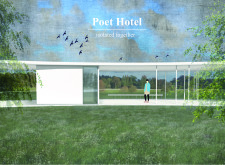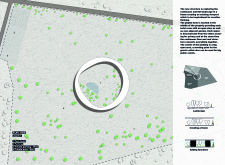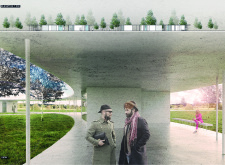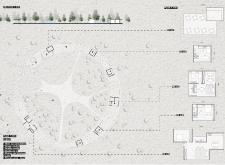5 key facts about this project
The concept of "isolated together" serves as the foundation of this design, highlighting the duality of solitude and community. Each guest room is arranged to ensure privacy while providing unobstructed sightlines to the natural environment. This approach encourages a unique experience where guests can indulge in personal reflection and creative thought, all while being part of a vibrant community setting.
Material Selection and Spatial Arrangement
The materiality of the Poet Hotel is integral to its architectural identity. The careful selection of concrete, glass, wood, stone, and metal creates a cohesive structure that interacts with its surroundings. Concrete forms the primary structure, providing durability and a modern aesthetic. Large glass panels facilitate natural light and connect the indoor spaces with the outdoors. Wood elements introduce warmth, enhancing the tactile experience for guests, while stone walkways seamlessly blend with the terrain, promoting a dialogue between built and natural environments. Metal components contribute to structural integrity and safety while maintaining a contemporary design language.
The spatial configuration features a circular layout, which optimizes guest flow and accessibility. Pathways intertwine through both communal and private areas, allowing guests to navigate the hotel effortlessly. Each guest room is equipped with private gardens, promoting an intimate connection with nature. The central communal space serves as a venue for gatherings, enriching guest experiences through collaboration and interaction.
Innovative Spatial Concepts
The Poet Hotel distinguishes itself from conventional hospitality projects through its innovative approach to space and function. The design prioritizes the integration of natural landscape features with architectural elements to create a cohesive experience for guests. The emphasis on creating private gardens for each room fosters a direct relationship with the environment, encouraging organic engagement with surroundings. Furthermore, the circular organization of the hotel optimizes visual connections and accessibility, enhancing the sense of community and openness.
The incorporation of various programmatic elements, such as workshops and artist retreats, further sets this project apart. By providing spaces specifically designed for creativity and collaboration, the Poet Hotel serves as a multifunctional hub that appeals to a diverse range of guests, from artists seeking inspiration to groups looking for communal experiences.
For those interested in a deeper understanding of the architectural plans, sections, and overall design concepts, an exploration of the project presentation is recommended. This exploration will reveal further architectural ideas and details that define the Poet Hotel and its unique contributions to the field of architecture.


























